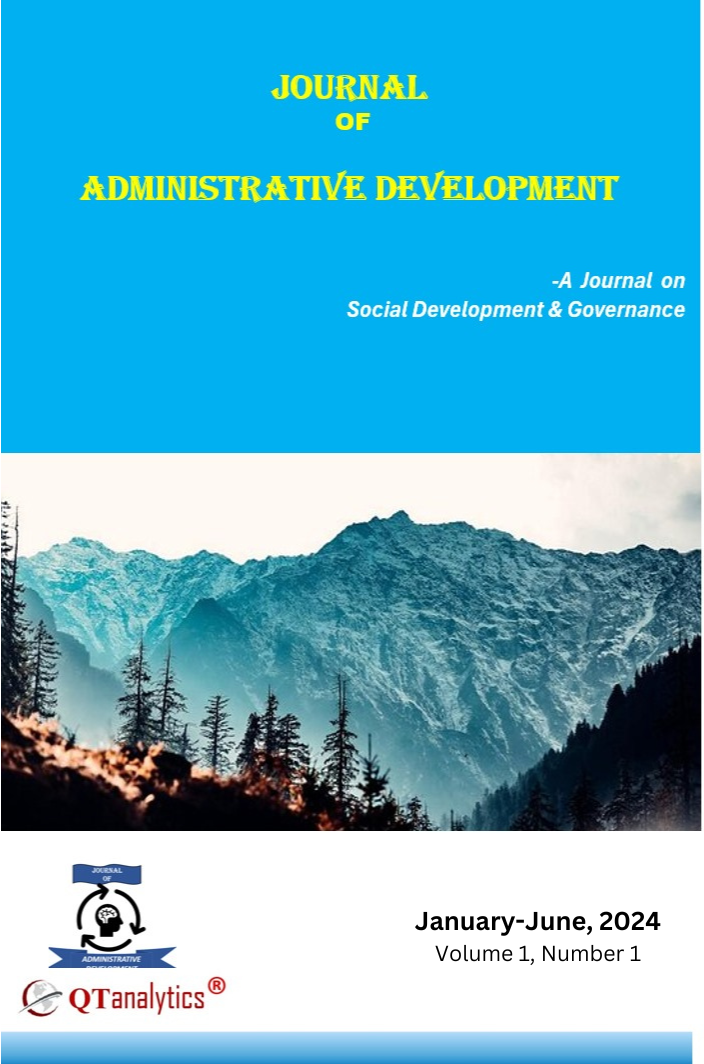Evaluation of Experiences in Human Capacity Development
DOI:
https://doi.org/10.48001/jad.202421.125-148Keywords:
Human Capacity, Competence based modules, Competency Framework, Traditional Approach of Training, Role clarityAbstract
Capacity development of officials in government is hardly considered as investment in human resource for harvesting dividends for employers. Consequently, training is mostly imparted in a mechanical manner which fails to add any value to the existing levels of knowledge, skills and competence of officials. Any initiative of human capacity development administered with active involvement of the leadership with an in-built monitoring system at different stages is an outcome-oriented experiment. The presented paper is a descriptive and commentary work of two such projects undertaken in the government sector with participation of a bi-lateral agency, it analyses experiences of a competence development project executed for capacity development of different official in different government institutions. The author has taken help from project documents besides institutional memories for scripting this work as author has been involved in planning, execution, and implementation of both projects on behalf of the bi-lateral agency. The findings of the projects indicated positive results in comparison to planned activities and interventions. The officials who participated in the learning programmes in the project have been reported to shown positive change besides competence development in the identified indicators of the spectrum. In addition to this, from the point of view of sustainability towards this initiative, the training institutions too have revised their curricula by incorporating the learnings of the project. The capacity development project planning, monitoring and implementation as explained in the work can be useful for the professionals and researchers who are engaged in the human capacity development sector.
References
1. Aantjes, C. J., Burrows, D., & Armstrong, R. (2021). Capacity development in pursuit of social change: an examination of processes and outcomes. Development in Practice, 32(4), 536–550. https://doi.org/10.1080/09614524.2021.1937547
2. Action Learning and Exposure Programme” (ALEP) under the project “Strengthening Management Capacities for International Cooperation” (CICM)
3. Boyatzis, R. (1982). The Competent Manager. New York: John Wiley. [8]. B
4. Chouhan, V.S., & Srivastava, S. (2014). Understanding Competencies and Competency Modeling ? A Literature Survey. IOSR Journal of Business and Management, 16, 14-22.
5. CICM & SCITP Project Documents, Department of Economic Affairs, Ministry of Finance, Govt of India, New Delhi
6. Competency Dictionary for Civil Services, UNDP & Training Division Department of Personnel & Training Old JNU Campus New Delhi-110067 India available at https://dopt.gov.in/sites/default/files/Competency%20Dictionary%20for%20the%20Civil%20Services.pdf
7. Danquah, J. K., Crocco, O. S., Mahmud, Q. M., Rehan, M., & Rizvi, L. J. (2022). Connecting concepts: bridging the gap between capacity development and human resource development. Human Resource Development International, 26(3), 246–263. https://doi.org/10.1080/13678868.2022.2108992
8. DeCorby-Watson K, Mensah G, Bergeron K, Abdi S, Rempel B, Manson H. Effectiveness of capacity building interventions relevant to public health practice: a systematic review. BMC Public Health. 2018 Jun 1;18(1):684. doi: 10.1186/s12889-018-5591-6. PMID: 29859075; PMCID: PMC5984748.
9. Indian Civil Services, Competency based Human Resource Management, Implementation Tool Kit, UNDP & Training Division Department of Personnel & Training Old JNU Campus New Delhi-110067 India available at https://dopt.gov.in/sites/default/files/Implementation%20Tool-kit.pdf
10. National Training Policy, 1996, Training Division, Department of Personnel and Training, Ministry of Personnel, Public Grievances and Pensions, Government of India, New Delhi available at http://14.139.60.153/bitstream/123456789/7760/1/NATIONAL%20TRAINING%20POLICY_TRAINING%20DIVISION%20DEPARTMENT%20OF%20PERSONNEL%20AND%20TRAINING_D-9703.pdf
11. Paul Wong’s PURE Model available at http://www.drpaulwong.com/the-pure-strategy-for-organizational-excellence/
12. Pinto, P.P. (1975). Job Descriptions for Executives-Revisited. Academy of management Proceedings, 228-230.
13. Rankin, N. (2002). Raising performance through people: The ninth competency survey. Competency and Emotional Intelligence, pp 2-21.
14. Rothwell, W., Bernthal, Paul R., Colteryahn, Karen, Davis, Patty, Naughton, Jennifer, & Wellins, Rich (2004). ASTD competency study: Mapping the future. Virginia: ASTD Press.
15. Suar, D. & Dan, A. (2001). Competency Assessment and Need Identification for Training. IJTD Journal, XXXI (4): 68-76
16. Whitley, R. (1989). On the Nature of Managerial Tasks and Skills: Their Distinguishing Characteristics and Organization. Journal of Management Studies, 26(3): 209-224.

Downloads
Published
Issue
Section
License
Copyright (c) 2024 QTanalytics India (Publications)

This work is licensed under a Creative Commons Attribution-NonCommercial 4.0 International License.
All QTanalytics journals are published Open Access. Articles are licensed under an open access licensed under Creative Commons Attribution-NonCommercial 4.0 International License. In addition, the article may be reused and quoted provided that the original published version is cited. These conditions allow for maximum use and exposure of the work, while ensuring that the authors receive proper credit.
 journals@qtanalytics.in, support@qtanalytics.in | Phone: +91-9458270556
journals@qtanalytics.in, support@qtanalytics.in | Phone: +91-9458270556